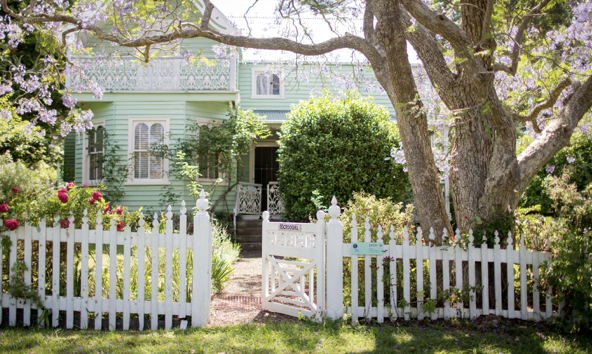
Meroogal House, in West Street, Nowra, was built in 1886 and is maintained by Museums of History NSW. Photo: Douglas Riley Photographer.
Protective clothing – gowns, gloves, hairnets. Not the prettiest sight. But an imperative in food, medical and industrial environments. Or when studying the artifacts of a historic home or site.
That’s what visitors to Meroogal House in Nowra have to do. But the disinclination to don ugly things over your socks is swiftly supplanted by the cultural magnitude of this property.
The home, which dates back to 1886, passed through the hands of four generations of women from the same family and offers us a glimpse of how they lived from that time until about 1950.
Not only that, it contains the most intact collection of Victorian-period furniture and other related house contents known in urban NSW.
It’s at the showground end of West Street and is best described as a capsule of history – a well-preserved one.
According to Dr Matthew Stephens, research librarian at Museums of History NSW: “It’s modest in comparison to Sydney’s grand late-19th-century houses but it’s certainly impressive compared to other Nowra homes of the same period. Banks and hotels were the only buildings of greater value.”
Museums of History NSW is entrusted with the care and maintenance of historic sites, objects and materials related to those buildings and the State Archives Collection. Other properties that fall under its auspices include Rose Seidler House, Hyde Park Barracks and Rouse Hill Estate. But there was a time before this caretaker came along.

The garden and fence at Meroogal House were restored to appear as they did in the 1920s. Photo: James Horan Photographer.
The late-Victorian, two-storey weatherboard cottage was a family home designed and built by Kenneth Mackenzie for his sister, the widowed Jessie Thorburn, and her four daughters. In the years that ensued, the house, on about one hectare, was lovingly painted and redecorated. A garden was planted. Residents from the same family came and went.
In the 1890s, a new kitchen was added. About 20 years later, telephone lines and town water arrived. Then in the mid-1920s, two of the original Thorburn daughters – who had lived there with their mother Jessie from the late 1860s onwards – moved back in and resumed the orderly domestic regimen developed in the previous century.
“The property, associated documents and belongings provide a rare glimpse into the lives of these women,” Dr Stephens said.
The exteriors of the building have remained largely the same – ice green with white trims. A team of experts was recently appointed to restore them to their former glory. Gothic details abound: elaborate bargeboards, cast-iron balustrades, Juliet balconies, and dormer windows. Even the garden is frozen in time. Well, sort of …
“The garden was restored to its appearance in the ’20s,” Dr Stephens said. ”The picket fence and flowerbeds were reconstructed and a host of perennial and annual plants were reintroduced.”
Visitors to the interiors are propelled back in time: vaulted ceilings, panelled doors, cast-iron fireplaces, gilded books, lace pillowcases, and dominos crafted from ebony and ivory.

Art lovers congregate in the garden of the historically significant property for the annual Meroogal Women’s Art Prize. Photo: James Horan Photographer.
The lives of the women who resided here for almost 100 years are palpable. It is due to the care of its custodians and endeavours such as the annual Meroogal Women’s Art Prize.
This highly regarded award, now in its 19th year, pays tribute to the former inhabitants of the property.
It invites women artists from around NSW to create works that respond to the house and its sense of place – historically and contemporaneously.
For that I would wear anything at all – ugly foot coverings included.
Meroogal House is open on Saturdays from 10 am to 4 pm. Museum entry is by guided tour only. Find out more information on the Museums of History NSW website.






